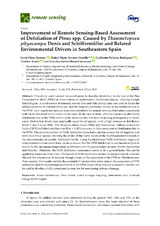Mostrar el registro sencillo del ítem
Improvement of Remote Sensing-Based Assessment of Defoliation of Pinus spp. Caused by Thaumetopoea pityocampa Denis and Schiffermüller and Related Environmental Drivers in Southeastern Spain
| dc.contributor.author | Pérez Romero, Javier | |
| dc.contributor.author | Navarro Cerrillo, Rafael M. | |
| dc.contributor.author | Palacios Rodríguez, Guillermo | |
| dc.contributor.author | Acosta, Cristina | |
| dc.contributor.author | Mesas Carrascosa, Francisco Javier | |
| dc.date.accessioned | 2020-06-30T12:37:08Z | |
| dc.date.available | 2020-06-30T12:37:08Z | |
| dc.date.issued | 2019 | |
| dc.identifier.uri | http://hdl.handle.net/10396/20260 | |
| dc.description.abstract | This study used Landsat temporal series to describe defoliation levels due to the Pine Processionary Moth (PPM) in Pinus forests of southeastern Andalusia (Spain), utilizing Google Earth Engine. A combination of remotely sensed data and field survey data was used to detect the defoliation levels of different Pinus spp. and the main environmental drivers of the defoliation due to the PPM. Four vegetation indexes were also calculated for remote sensing defoliation assessment, both inside the stand and in a 60-m buffer area. In the area of study, all Pinus species are affected by defoliation due to the PPM, with a cyclic behavior that has been increasing in frequency in recent years. Defoliation levels were practically equal for all species, with a high increase in defoliation levels 2 and 3 since 2014. The Moisture Stress Index (MSI) and Normalized Difference Infrared Index (NDII) exhibited similar overall (p < 0.001) accuracy in the assessment of defoliation due to the PPM. The synchronization of NDII-defoliation data had a similar pattern for all together and individual Pinus species, showing the ability of this index to adjust the model parameters based on the characteristics of specific defoliation levels. Using Landsat-based NDII-defoliation maps and interpolated environmental data, we have shown that the PPM defoliation in southeastern Spain is driven by the minimum temperature in February and the precipitation in June, March, September, and October. Therefore, the NDII-defoliation assessment seems to be a general index that can be applied to forests in other areas. The trends of NDII-defoliation related to environmental variables showed the importance of summer drought stress in the expansion of the PPM on Mediterranean Pinus species. Our results confirm the potential of Landsat time-series data in the assessment of PPM defoliation and the spatiotemporal patterns of the PPM; hence, these data are a powerful tool that can be used to develop a fully operational system for the monitoring of insect damage. | es_ES |
| dc.format.mimetype | application/pdf | es_ES |
| dc.language.iso | eng | es_ES |
| dc.publisher | MDPI | es_ES |
| dc.rights | https://creativecommons.org/licenses/by/4.0/ | es_ES |
| dc.source | Remote Sensing 11(14), 1736 (2019) | es_ES |
| dc.subject | Forest disturbance | es_ES |
| dc.subject | Pinus forest | es_ES |
| dc.subject | Insect damage mapping | es_ES |
| dc.subject | Time-series data | es_ES |
| dc.subject | Landsat | es_ES |
| dc.subject | Google Earth Engine | es_ES |
| dc.title | Improvement of Remote Sensing-Based Assessment of Defoliation of Pinus spp. Caused by Thaumetopoea pityocampa Denis and Schiffermüller and Related Environmental Drivers in Southeastern Spain | es_ES |
| dc.type | info:eu-repo/semantics/article | es_ES |
| dc.relation.publisherversion | http://dx.doi.org/10.3390/rs11141736 | es_ES |
| dc.relation.projectID | Gobierno de España. CGL2017-86161-R (ESPECTRAMED) | es_ES |
| dc.relation.projectID | Unión Europea. LIFE14 CCM/ES/001271 (LIFE FOREST CO2) | es_ES |
| dc.rights.accessRights | info:eu-repo/semantics/openAccess | es_ES |

